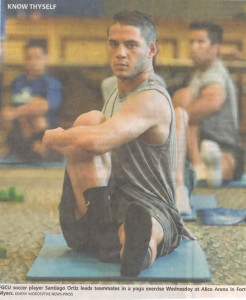Finding the center with elite athletes
By Nancy B. Loughlin
Published in News Press on March 25, 2014. Posted with permission.
Don’t. Leak. Energy.
For athletes or any committed types, this is good advice.
The Florida Gulf Coast University (FGCU) soccer team has been practicing yoga twice a week with Gary Granza since August 2013.
In a typical practice, Granza and his thick New York City accent move through 20 elite athletes. They lie on their backs, pulling their right legs into their chests, grimacing and straining with effort, sometimes pain.
One player tries to text while stretching, and Granza hovers, reminds him about leaking energy, and then offers this second piece of sage advice: “Don’t be an asshole.”
These are young men.
The texter stuffs his phone into his sneaker and returns to the deep stretch, groaning.
They’re tight. Very tight. Typical Type As. And they respond well to brusque dharma talk.
The FGCU soccer player rises at dawn. He works out in the gym before an 8:30 a.m. practice. He attends classes all day only to work out again around dinner. There’s study time and a minimal amount of socializing, and the cycle repeats the next day. That’s off season.
They may be elite athletes, but they are also facing the same challenges as other college students. Assistant coach Chris Gores describes the typical student athlete as one who is away from home for the first time, perhaps being academically challenged for the first time. Tasting freedom for the first time.
An elite athlete cannot afford to leak energy.
The key in Granza’s instruction is the meaning of the word “Namaste.” Granza usually avoids Sanskrit in his athletic training, but he recently added this traditional yogic closing to the soccer practice.
This young team is looking for leaders.
Namaste, in its simplest translation, means “I bow to you.” One yogi acknowledges his unity with another. Extending it, when one athlete says Namaste to another, it is an acknowledgement of the unification of the team; by saying Namaste, they strive to play as one.
Head coach Bob Butehorn notes that an athlete’s skill is not isolated in the body nor is it isolated in the mind. It is a melding of body, mind and spirit.
Yoga means union. The yoga calms the fluctuations of the mind, enables the athlete to persevere in the face of adversity. He can respond calmly to visual and mental cues. Above all, the mature, balanced and intuitive mind makes the student athlete coachable.
This training is for the field, the classroom and life. Retain the energy. It’s how expertise grows.
This is above and beyond the initial yoga program goals of lessening the severity of and hopefully deceasing injuries and prompting faster recovery time after workouts, practice and games.
The Elite Flow
The priorities for elite athletes are opening the lower body, releasing the back and shoulders and focusing the mind.
Begin in seated meditation to still the mind and regulate the breathing. Eyes are closed. Inhale, lift your hands overhead; exhale opening the arms while twisting right and left.
The Lower Body
Like any Type A, constantly doing, constantly acting, the lower body is going to compress.
From seated meditation, release the feet into Cobbler’s Pose. Soles of the feet are touching and knees drop open. Use the elbows to press the thighs to the floor.
Recline on the back, legs long. Pull the right knee into the chest. Loop a strap around the ball of the foot, and straighten the leg perpendicular to the floor, holding the strap in your hands. Allow the leg to sway side to side; circle the leg. Stretch the hamstring. Then, hold the strap in your right hand, left arm to T, and drop the straight right leg open to an inch away from the floor. Hold the stretch before switching sides.
Seated forward bend. Inhale, and lengthen the spine. Exhale, and drop the torso to the legs. Reach the heart to the feet. Hold and breathe.
Release the Back
Swing the legs behind you and push to Downward Facing Dog. Spread the shoulder blades wide to decrease the tension in the neck and spine. Drop your head.
Return to the mat, lie on your back, and push up into Bridge Pose. Head, shoulders and feet are on the floor. Push your hips to the ceiling and hold. Knees are an inch apart. Support your lower back with your hands, or grab the back of your heels. If you are ready, only if you are ready, push into Wheel (backbend). Hands are flat on the floor above the shoulders, fingertips facing the body. Feet are on the floor, hips to the sky.
Still the Mind
If you can swing it, work handstand.
Handstand forces everyone to confront their insecurities and nervousness. It’s not a physically difficult pose once your legs are in the air. But that is the trick.
Practice using the wall. Take Downward Facing Dog with your heels pressed against the wall. Walk your feet up the wall for half-handstand. Walk your hands closer to the wall. Alternate lifting one foot at a time to the ceiling, perhaps both simultaneously.
Use that driven core of fire to keep you steady. In time, you’ll hold the legs away from the wall.
Sit, and ground yourself in meditation. Bask in your achievements for as long as you like.

